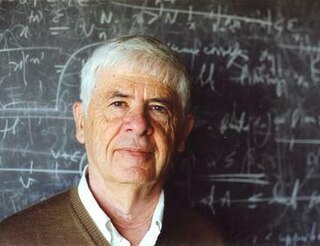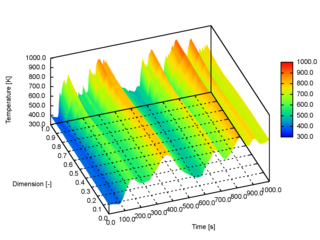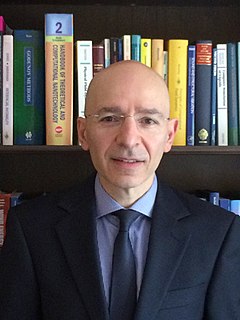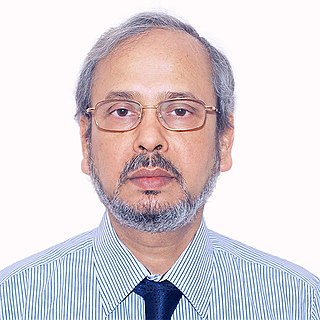Related Research Articles

In fluid mechanics, two-phase flow is a flow of gas and liquid — a particular example of multiphase flow. Two-phase flow can occur in various forms, such as flows transitioning from pure liquid to vapor as a result of external heating, separated flows, and dispersed two-phase flows where one phase is present in the form of particles, droplets, or bubbles in a continuous carrier phase.

Level-set methods (LSM) are a conceptual framework for using level sets as a tool for numerical analysis of surfaces and shapes. The advantage of the level-set model is that one can perform numerical computations involving curves and surfaces on a fixed Cartesian grid without having to parameterize these objects. Also, the level-set method makes it very easy to follow shapes that change topology, for example, when a shape splits in two, develops holes, or the reverse of these operations. All these make the level-set method a great tool for modeling time-varying objects, like inflation of an airbag, or a drop of oil floating in water.
AUSM stands for Advection Upstream Splitting Method. It is developed as a numerical inviscid flux function for solving a general system of conservation equations. It is based on the upwind concept and was motivated to provide an alternative approach to other upwind methods, such as the Godunov method, flux difference splitting methods by Roe, and Solomon and Osher, flux vector splitting methods by Van Leer, and Steger and Warming. The AUSM first recognizes that the inviscid flux consist of two physically distinct parts, i.e., convective and pressure fluxes. The former is associated with the flow (advection) speed, while the latter with the acoustic speed; or respectively classified as the linear and nonlinear fields. Currently, the convective and pressure fluxes are formulated using the eigenvalues of the flux Jacobian matrices. The method was originally proposed by Liou and Steffen for the typical compressible aerodynamic flows, and later substantially improved in to yield a more accurate and robust version. To extend its capabilities, it has been further developed in for all speed-regimes and multiphase flow. Its variants have also been proposed.

In fluid mechanics, multiphase flow is the simultaneous flow of materials with two or more thermodynamic phases. Virtually all processing technologies from cavitating pumps and turbines to paper-making and the construction of plastics involve some form of multiphase flow. It is also prevalent in many natural phenomena.

Alexandre Joel Chorin is an American mathematician known for his contributions to computational fluid mechanics, turbulence, and computational statistical mechanics.
The material point method (MPM) is a numerical technique used to simulate the behavior of solids, liquids, gases, and any other continuum material. Especially, it is a robust spatial discretization method for simulating multi-phase (solid-fluid-gas) interactions. In the MPM, a continuum body is described by a number of small Lagrangian elements referred to as 'material points'. These material points are surrounded by a background mesh/grid that is used to calculate terms such as the deformation gradient. Unlike other mesh-based methods like the finite element method, finite volume method or finite difference method, the MPM is not a mesh based method and is instead categorized as a meshless/meshfree or continuum-based particle method, examples of which are smoothed particle hydrodynamics and peridynamics. Despite the presence of a background mesh, the MPM does not encounter the drawbacks of mesh-based methods which makes it a promising and powerful tool in computational mechanics.
Hubert Chanson is a professional engineer and academic in hydraulic engineering and environmental fluid mechanics. Since 1990 he has worked at the University of Queensland.
Andrea Prosperetti is the Distinguished Professor of Mechanical Engineering at the University of Houston, the Berkhoff Professor of Applied Physics at the University of Twente in the Netherlands and an elected member of the National Academy of Engineering in 2012. He is known for his work in the field of multiphase flows including bubble dynamics and cavitation.
Mohammed Yousuff Hussaini is an Indian born American applied mathematician. He is the Sir James Lighthill Professor of Mathematics and Computational Science & Engineering at the Florida State University, United States. Hussaini is also the holder of the TMC Eminent Scholar Chair in High Performance Computing at FSU. He is widely known for his research in scientific computation, particularly in the field of computational fluid dynamics (CFD) and Control and optimization. Hussaini co-authored the popular book Spectral Methods in Fluid Dynamics with Claudio Canuto, Alfio Quarteroni, and Thomas Zang. He is the editor-in-chief of the journal Theoretical and Computational Fluid Dynamics.
The moving particle semi-implicit (MPS) method is a computational method for the simulation of incompressible free surface flows. It is a macroscopic, deterministic particle method developed by Koshizuka and Oka (1996).

Phillip Colella is an American applied mathematician and a member of the Applied Numerical Algorithms Group at the Lawrence Berkeley National Laboratory. He has also worked at Lawrence Livermore National Laboratory. He is known for his fundamental contributions in the development of mathematical methods and numerical tools used to solve partial differential equations, including high-resolution and adaptive mesh refinement schemes. Colella is a member of the US National Academy of Sciences.
In applied mathematics, the name finite pointset method is a general approach for the numerical solution of problems in continuum mechanics, such as the simulation of fluid flows. In this approach the medium is represented by a finite set of points, each endowed with the relevant local properties of the medium such as density, velocity, pressure, and temperature.
The multiphase particle-in-cell method (MP-PIC) is a numerical method for modeling particle-fluid and particle-particle interactions in a computational fluid dynamics (CFD) calculation. The MP-PIC method achieves greater stability than its particle-in-cell predecessor by simultaneously treating the solid particles as computational particles and as a continuum. In the MP-PIC approach, the particle properties are mapped from the Lagrangian coordinates to an Eulerian grid through the use of interpolation functions. After evaluation of the continuum derivative terms, the particle properties are mapped back to the individual particles. This method has proven to be stable in dense particle flows, computationally efficient, and physically accurate. This has allowed the MP-PIC method to be used as particle-flow solver for the simulation of industrial-scale chemical processes involving particle-fluid flows.

The extended discrete element method (XDEM) is a numerical technique that extends the dynamics of granular material or particles as described through the classical discrete element method (DEM) by additional properties such as the thermodynamic state, stress/strain or electro-magnetic field for each particle. Contrary to a continuum mechanics concept, the XDEM aims at resolving the particulate phase with its various processes attached to the particles. While the discrete element method predicts position and orientation in space and time for each particle, the extended discrete element method additionally estimates properties such as internal temperature and/or species distribution or mechanical impact with structures.
The following is a timeline of numerical analysis after 1945, and deals with developments after the invention of the modern electronic computer, which began during Second World War. For a fuller history of the subject before this period, see timeline and history of mathematics.

Dimitris Drikakis, PhD, FRAeS, CEng, is a Greek-British applied scientist, engineer and university professor. His research is multidisciplinary. It covers fluid dynamics, computational fluid dynamics, acoustics, heat transfer, computational science from molecular to macro scale, materials, machine learning, and emerging technologies. He has applied his research to diverse fields such as Aerospace & Defence, Biomedical, and Energy and Environment Sectors. He received The William Penney Fellowship Award by the Atomic Weapons Establishment to recognise his contributions to compressible fluid dynamics. He was also the winner of NEF's Innovator of the Year Award by the UK's Institute of Innovation and Knowledge Exchange for a new generation carbon capture nanotechnology that uses carbon nanotubes for filtering out carbon dioxide and other gases.

John Francis Brady is an American chemical engineer and the Chevron Professor of Chemical Engineering and Mechanical Engineering at the California Institute of Technology. He is a fluid mechanician and creator of the Stokesian dynamics method for simulating suspensions of spheres and ellipsoids in low Reynolds number flows. He is an elected fellow of the American Physical Society, a fellow of the Society of Rheology, as well as a member of the National Academy of Sciences, the National Academy of Engineering, and the American Academy of Arts and Sciences.

Gautam Biswas is presently a professor of mechanical engineering at the Indian Institute of Technology (IIT) Kanpur. Earlier, he has been the director of Indian Institute of Technology Guwahati, and director of the CSIR - Central Mechanical Engineering Research Institute at Durgapur. As a faculty member of IIT Kanpur, he has served the Institute in various capacities including the Dean of Academic Affairs. Prof Gautam Biswas is a Fellow of the three science academies, such as, the Indian National Science Academy, the Indian Academy of Sciences and the National Academy of Sciences India. He is a Fellow of the Indian National Academy of Engineering (INAE) and Institution of Engineers (IEI). He was the occupant of the position of GD and VM Mehta Endowed Chair Professor of Mechanical Engineering at the Indian Institute of Technology Kanpur. A Fellow of the American Society of Mechanical Engineers (ASME), Prof Biswas is the author of more than 150 scientific publications and guided 23 PhD theses. In the year 2011, he was awarded the esteemed J C Bose National Fellowship by the Department of Science and Technology, Government of India. Biswas completed his B.E. from IIEST(Erstwhile B.E. College under Calcutta University) in 1979. He completed his PhD from the Indian Institute of Technology Kharagpur in 1985. He was an Alexander von Humboldt Fellow at the Ruhr University Bochum in Germany and JSPS Invitation Fellow at the Yokohama National University, Japan. He has been a guest professor at the Friedrich-Alexander-Universität Erlangen-Nürnberg, Germany. Prof. Biswas was awarded an honorary doctorate by the Aristotle University of Thessaloniki, Greece, in 2018. In recognition of his stellar contribution in the fields of Fluid Mechanics and Thermal Sciences, his contributions as an academic administrator and his dedicated service to the institute, IIT Kanpur bestowed upon Professor Gautam Biswas the award of Institute Fellow for the year 2020.

Joseph Katz is an Israel-born American fluid dynamicist, known for his work on experimental fluid mechanics, cavitation phenomena and multiphase flow, turbulence, turbomachinery flows and oceanography flows, flow-induced vibrations and noise, and development of optical flow diagnostics techniques, including Particle Image Velocimetry (PIV) and Holographic Particle Image Velocimetry (HPIV). As of 2005, he is the William F. Ward Sr. Distinguished Professor at the Department of Mechanical Engineering of the Whiting School of Engineering at the Johns Hopkins University.
Daniel Attinger is a mechanical engineer, researcher and an academic. He owns a US-based scientific consulting company.
References
- ↑ "Home".
- ↑ "Home".
- ↑ Journal of Computational Physics
- ↑ Unverdi, S. O. and Tryggvason, G. (1992), A Front-Tracking Method for Viscous, Incompressible, Multi-Fluid Flows, J. Comput. Phys., 100, 25-37.
- ↑ Tryggvason, G., Bunner, B., Esmaeeli, A., Juric, D., Al-Rawahi, N., Tauber, W., Han, J., Nas, S., and Jan, Y.-J. (2001), A Front Tracking Method for the Computations of Multiphase Flows, J. Comput. Phys., 169, 708-759.